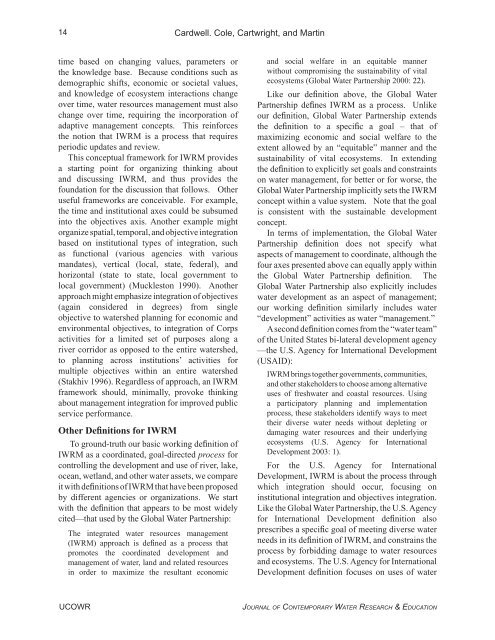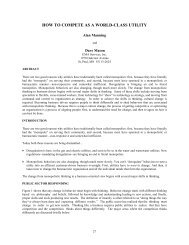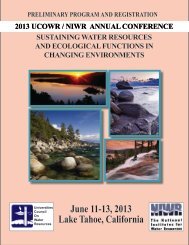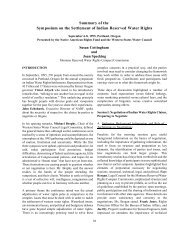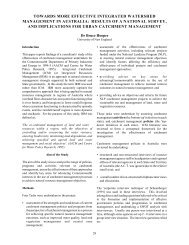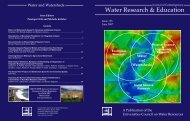14Cardwell. Cole, Cartwright, <strong>and</strong> Martintime based on changing values, parameters orthe knowledge base. Because conditions such asdemographic shifts, economic or societal values,<strong>and</strong> knowledge <strong>of</strong> ecosystem interactions changeover time, water resources management must alsochange over time, requiring the incorporation <strong>of</strong>adaptive management concepts. This reinforcesthe notion that IWRM is a process that requiresperiodic updates <strong>and</strong> review.This conceptual framework for IWRM providesa starting point for organizing thinking about<strong>and</strong> discussing IWRM, <strong>and</strong> thus provides thefoundation for the discussion that follows. Otheruseful frameworks are conceivable. For example,the time <strong>and</strong> institutional axes could be subsumedinto the objectives axis. Another example mightorganize spatial, temporal, <strong>and</strong> objective integrationbased on institutional types <strong>of</strong> integration, suchas functional (various agencies with variousm<strong>and</strong>ates), vertical (local, state, federal), <strong>and</strong>horizontal (state to state, local government tolocal government) (Muckleston 1990). Anotherapproach might emphasize integration <strong>of</strong> objectives(again considered in degrees) from singleobjective to watershed planning for economic <strong>and</strong>environmental objectives, to integration <strong>of</strong> Corpsactivities for a limited set <strong>of</strong> purposes along ariver corridor as opposed to the entire watershed,to planning across institutions’ activities formultiple objectives within an entire watershed(Stakhiv 1996). Regardless <strong>of</strong> approach, an IWRMframework should, minimally, provoke thinkingabout management integration for improved publicservice performance.Other Definitions for IWRMTo ground-truth our basic working definition <strong>of</strong>IWRM as a coordinated, goal-directed process forcontrolling the development <strong>and</strong> use <strong>of</strong> river, lake,ocean, wetl<strong>and</strong>, <strong>and</strong> other water assets, we compareit with definitions <strong>of</strong> IWRM that have been proposedby different agencies or organizations. We startwith the definition that appears to be most widelycited—that used by the Global <strong>Water</strong> Partnership:The integrated water resources management(IWRM) approach is defined as a process thatpromotes the coordinated development <strong>and</strong>management <strong>of</strong> water, l<strong>and</strong> <strong>and</strong> related resourcesin order to maximize the resultant economic<strong>and</strong> social welfare in an equitable mannerwithout compromising the sustainability <strong>of</strong> vitalecosystems (Global <strong>Water</strong> Partnership 2000: 22).Like our definition above, the Global <strong>Water</strong>Partnership defines IWRM as a process. Unlikeour definition, Global <strong>Water</strong> Partnership extendsthe definition to a specific a goal – that <strong>of</strong>maximizing economic <strong>and</strong> social welfare to theextent allowed by an “equitable” manner <strong>and</strong> thesustainability <strong>of</strong> vital ecosystems. In extendingthe definition to explicitly set goals <strong>and</strong> constraintson water management, for better or for worse, theGlobal <strong>Water</strong> Partnership implicitly sets the IWRMconcept within a value system. Note that the goalis consistent with the sustainable developmentconcept.In terms <strong>of</strong> implementation, the Global <strong>Water</strong>Partnership definition does not specify whataspects <strong>of</strong> management to coordinate, although thefour axes presented above can equally apply withinthe Global <strong>Water</strong> Partnership definition. TheGlobal <strong>Water</strong> Partnership also explicitly includeswater development as an aspect <strong>of</strong> management;our working definition similarly includes water“development” activities as water “management.”A second definition comes from the “water team”<strong>of</strong> the United States bi-lateral development agency—the U.S. Agency for International Development(USAID):IWRM brings together governments, communities,<strong>and</strong> other stakeholders to choose among alternativeuses <strong>of</strong> freshwater <strong>and</strong> coastal resources. Usinga participatory planning <strong>and</strong> implementationprocess, these stakeholders identify ways to meettheir diverse water needs without depleting ordamaging water resources <strong>and</strong> their underlyingecosystems (U.S. Agency for InternationalDevelopment 2003: 1).For the U.S. Agency for InternationalDevelopment, IWRM is about the process throughwhich integration should occur, focusing oninstitutional integration <strong>and</strong> objectives integration.Like the Global <strong>Water</strong> Partnership, the U.S. Agencyfor International Development definition alsoprescribes a specific goal <strong>of</strong> meeting diverse waterneeds in its definition <strong>of</strong> IWRM, <strong>and</strong> constrains theprocess by forbidding damage to water resources<strong>and</strong> ecosystems. The U.S. Agency for InternationalDevelopment definition focuses on uses <strong>of</strong> waterUCOWRJOURNAL OF CONTEMPORARY WATER RESEARCH & EDUCATION
IWRM: Defi nitions <strong>and</strong> Conceptual Musings15<strong>and</strong> ways for stakeholders to meet their waterneeds. Such a focus may limit the integration tomanagement activities that directly impact wateruse. Like the Global <strong>Water</strong> Partnership, the U.S.Agency for International Development does notspecify the aspects <strong>of</strong> management that will beintegrated. Also like the Global <strong>Water</strong> Partnership,the goal is consistent with the sustainabledevelopment concept.A third source is the World Bank:An integrated water resources perspectiveensures that social, economic, environmental <strong>and</strong>technical dimensions are taken into account in themanagement <strong>and</strong> development <strong>of</strong> water resources(World Bank 2003a:1).The World Bank’s integrated water resources“perspective” requires that multiple dimensionsor objectives be considered in water resourcesmanagement. This “perspective” is supplementedby the Bank’s 2003 policy paper that strongly <strong>and</strong>explicitly endorses integrated water resourcesmanagement (World Bank 2003b). While the2003 paper does not define IWRM, it does referto it as a goal <strong>and</strong>, through a reference to “goodIWRM” implies that there are degrees <strong>of</strong> suchintegration. Although generally regarded as astrong endorsement <strong>of</strong> IWRM concepts (WorldBank 2003b), the Bank’s 1993 water policy paper(World Bank 1993) does not define or explicitlypromote the term “Integrated <strong>Water</strong> ResourcesManagement.” Overall, the Bank assumes thedefinition <strong>of</strong> IWRM is implicit <strong>and</strong> insteadconcentrates on potential Bank <strong>and</strong> governmentactions to improve management. This IWRMconcept is primarily procedural <strong>and</strong> only vaguelyimplies a sustainable development goal through theeconomic, environmental. <strong>and</strong> social dimensionsthat need to be “taken into account.”The United Nations Development Programme(UNDP):Integrated water resources management is basedon the perception <strong>of</strong> water as an integral part <strong>of</strong>the ecosystem, a natural resource <strong>and</strong> social <strong>and</strong>economic good (United Nations DevelopmentProgramme 1990: 22).The use <strong>of</strong> the term IWRM by the UnitedNations Development Programme emphasizesa broad perception <strong>of</strong> water having ecological,natural resources, <strong>and</strong> social <strong>and</strong> economic aspects.The emphasis is to enlarge the perception <strong>of</strong> therole <strong>of</strong> water; a broader perception <strong>of</strong> the multipleroles <strong>of</strong> water resources will thus lead to integrationacross objectives such as social, economic, <strong>and</strong>environmental, if not time, institutions <strong>and</strong> space.This “definition” is more derivative (where theconcept comes from) <strong>and</strong> is less procedural orgoal-oriented than others presented here.The Inter-American Development Bank (IADB)<strong>of</strong>fers one <strong>of</strong> the more elaborate definitions:Integrated <strong>Water</strong> Resources Management: waterresources management where the aim <strong>of</strong> itsactions <strong>and</strong> projects also includes the allocation<strong>of</strong> water <strong>and</strong> decreasing <strong>of</strong> conflicts betweencompetitive water resource subsectors <strong>and</strong> uses,both in quantity <strong>and</strong> in quality. Sometimes it isalso referred to as comprehensive water resourcesmanagement…It is the process <strong>of</strong> diagnosing,responding to <strong>and</strong> resolving water use problems[while] acknowledging their interrelationships(Inter-American Development Bank 1998: 3).The Inter-American Development Bank definesIWRM as a process with the goal <strong>of</strong> reducing conflictover both water quality <strong>and</strong> quantity. The definitionexplicitly refers to various uses or objectives forwater management. By defining conflict reductionas the distinctive element <strong>of</strong> IWRM, the definitionimplies consideration <strong>of</strong> multiple objectives, thatvarious institutions are involved, that analysis isspatially integrated, <strong>and</strong> that conflicts might occurover time. The Inter-American Development Banksees integrated water resources management asa change in paradigm—“from development tomanagement <strong>and</strong> from a sectoral to an integratedapproach” (Inter-American Development Bank1998: 16).The IWRM concepts summarized above goconsiderably beyond the idea <strong>of</strong> at least someintegration across space, institutions, objectives<strong>and</strong> time. The concepts refer to diverse water needs,the perception <strong>of</strong> water as a social <strong>and</strong> economicgood, <strong>and</strong> maximizing economic <strong>and</strong> social welfarein an equitable manner. Many m<strong>and</strong>ate specificways to achieve integration, such as participatoryplanning <strong>and</strong> conflict resolution. Others specifygoals <strong>of</strong> the integration. Most <strong>of</strong> the definitionsreflect the new consensus that the process <strong>of</strong> waterresources management needs to consider social,JOURNAL OF CONTEMPORARY WATER RESEARCH & EDUCATIONUCOWR
- Page 3: Journal of ContemporaryWater Resear
- Page 6 and 7: 2Bruce Hooperinstitutional, and tem
- Page 11 and 12: IWRM: Governance, Best Practice, an
- Page 13 and 14: IWRM: Defi nitions and Conceptual M
- Page 15 and 16: IWRM: Defi nitions and Conceptual M
- Page 17: IWRM: Defi nitions and Conceptual M
- Page 22 and 23: 18Cardwell. Cole, Cartwright, and M
- Page 24 and 25: 20Mostert26 water boards responsibl
- Page 26 and 27: 22MostertTable 1. Third National Wa
- Page 28 and 29: 24MostertImplementationThe ambitiou
- Page 30 and 31: 26MostertBiswas, A. K. 2004b. Respo
- Page 32 and 33: 28UNIVERSITIES COUNCIL ON WATER RES
- Page 34 and 35: 30Ashton, Turton, and Rouxresource
- Page 36 and 37: 32Ashton, Turton, and Rouxassumptio
- Page 38 and 39: 34Ashton, Turton, and RouxEffective
- Page 40 and 41: 36UNIVERSITIES COUNCIL ON WATER RES
- Page 42 and 43: 38Hussey and Doversin water policy
- Page 44 and 45: 40Hussey and Dovers1994 Council of
- Page 46 and 47: 42Hussey and Doversestablished Thes
- Page 48 and 49: 44Hussey and DoversTable 1. Typolog
- Page 50 and 51: 46Hussey and Doversassessment appro
- Page 52 and 53: 48Hussey and Doverspolicy goals.Bey
- Page 54 and 55: 50Hussey and DoversFrawley, K. 1994
- Page 56 and 57: 52Mitchelloften took three to four
- Page 58 and 59: 54Mitchelltree preservation plans;
- Page 60 and 61: 56UNIVERSITIES COUNCIL ON WATER RES
- Page 62 and 63: 58Genskow and Borna series of chall
- Page 64 and 65: 60Genskow and BornTable 1. Watershe
- Page 66 and 67: 62Genskow and Bornthe first Dungene
- Page 68 and 69:
64Genskow and BornWashington, DC.Ko
- Page 70 and 71:
66Green and Fernández-BilbaoWithin
- Page 72 and 73:
68Green and Fernández-Bilbaosubjec
- Page 74 and 75:
70Green and Fernández-Bilbaoinflue
- Page 76 and 77:
72Green and Fernández-BilbaoBerbel
- Page 78 and 79:
74UNIVERSITIES COUNCIL ON WATER RES
- Page 80 and 81:
76BallweberEstablish AdvisoryCommit
- Page 82 and 83:
78Ballweberattributes in others (Ch
- Page 84 and 85:
80UNIVERSITIES COUNCIL ON WATER RES
- Page 86 and 87:
82Barreiraand ground water. To this
- Page 88 and 89:
84Barreirawith other states for int
- Page 90 and 91:
86UNIVERSITIES COUNCIL ON WATER RES
- Page 92 and 93:
88Davis and ThrelfallResource Manag
- Page 94 and 95:
90Davis and ThrelfallTable 2. Thirt
- Page 96 and 97:
92Davis and Threlfallby regional an
- Page 98 and 99:
94Davis and Threlfallenforcement, a
- Page 100 and 101:
96Davis and Threlfallhusbandry prac
- Page 102 and 103:
98Davis and ThrelfallNew Zealand: T
- Page 104 and 105:
100UNIVERSITIES COUNCIL ON WATER RE
- Page 106 and 107:
102Lamoree and van SteenbergenIt is
- Page 108 and 109:
104Lamoree and van Steenbergenand n
- Page 110 and 111:
106Lamoree and van Steenbergeninter
- Page 112 and 113:
108BourgetWorks Planner Capability
- Page 114 and 115:
110Bourgetwith over 600 people resp
- Page 116 and 117:
112Bourgetgovernment’s intrusion
- Page 118 and 119:
114Bourget4.management, drought man
- Page 120 and 121:
116McKayFigure 1. The four paradigm
- Page 122 and 123:
118McKay4. Paradigm 4 (which commen
- Page 124 and 125:
120McKaythree main functions:1. ass
- Page 126 and 127:
122McKayState Implementation of the
- Page 128 and 129:
124McKayTable 2. Corporate governan
- Page 130 and 131:
126McKayFigure 4. Qu. 26 - The ESD
- Page 132 and 133:
128McKayFigure 7. Qu.93- This organ
- Page 134 and 135:
130McKayBrundtland Report. 1987. Ou
- Page 136 and 137:
132UCOWR BOARD OF DIRECTORS/COMMITT
- Page 138 and 139:
134BENEFITS OF UCOWR MEMBERSHIPThe
- Page 140 and 141:
136Past Issues of the Journal of Co
- Page 142 and 143:
138Academic Organizations Membershi
- Page 144 and 145:
140Individual Membership Applicatio
- Page 146 and 147:
Universities Council on Water Resou
- Page 148:
Integrated Water Resources Manageme


